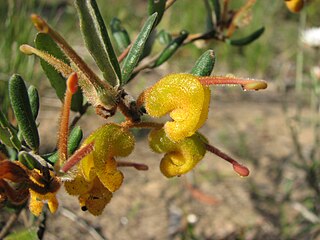
Grevillea chrysophaea, commonly known as golden grevillea, is a species of flowering plant in the family Proteaceae and is endemic to Victoria in Australia. It is a spreading shrub with oblong to almost linear leaves, and dull to golden yellow flowers with a red or orange-red style.

Grevillea floripendula, commonly known as Ben Major grevillea or drooping grevillea, is a species of flowering plant in the family Proteaceae and is endemic to a restricted area of Victoria, Australia. It is a spreading, low-lying to prostrate shrub with divided leaves with toothed lobes and clusters of greenish to mauve and blackish flowers with a yellow to red style.
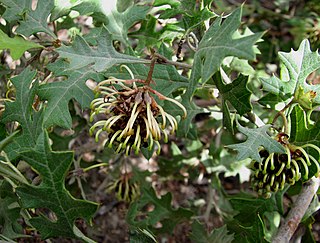
Grevillea dryophylla, also known as Goldfields grevillea, is a species of flowering plant in the family Proteaceae and is endemic to Victoria, Australia. It is a spreading to erect shrub with hairy branchlets, lobed leaves, and green to brown or yellow flowers.

Grevillea microstegia, commonly known as Mount Cassell grevillea, is a species of flowering plant in the family Proteaceae and is endemic to Victoria in Australia. It is a prostrate to low-lying or straggling shrub with deeply divided leaves, the end lobes triangular, and toothbrush-shaped clusters of reddish-brown flowers with a red style.

Grevillea obtecta, commonly known as Fryerstown grevillea, Elphinstone grevillea or Taradale grevillea, is a species of flowering plant in the family Proteaceae and is endemic to Victoria in Australia. It is a prostrate, clumping or straggling shrub with pinnatifid, pinnatipartite or toothed leaves, and toothbrush-like clusters of light green to yellowish and purplish to black flowers with a dull yellow to pink style.

Grevillea infecunda, commonly known as Anglesea grevillea, is a species of flowering plant in the family Proteaceae and is endemic to a restricted area of southern Victoria in Australia. It is a low-lying to weakly erect shrub with divided leaves with three to sixteen lobes or teeth and greenish-yellow flowers with a dull pink style.
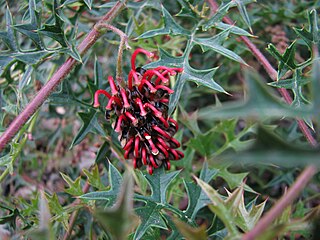
Grevillea montis-cole, commonly known as Mount Cole grevillea, is a species of flowering plant in the family Proteaceae and is endemic to central-western Victoria, Australia. It is a shrub with divided leaves with 5 to 15 lobes, the end lobes more or less triangular to narrowly oblong and sharply-pointed, and clusters of greenish to fawn and dull purplish flowers.

Grevillea bedggoodiana, commonly known as Enfield grevillea, is a species of flowering plant in the family Proteaceae and is endemic to a restricted area near Ballarat in Victoria, Australia. It is a prostrate to low-lying shrub with coarsely serrated, egg-shaped to oblong leaves and green and pink flowers.

Grevillea australis, commonly known as alpine grevillea or southern grevillea, is a species of flowering plant in the family Proteaceae and is endemic to south-eastern Australia. It is a spreading to prostrate shrub with simple, narrowly egg-shaped leaves and groups of white to pale pink flowers with a glabrous ovary.

Grevillea alpivaga, also known as buffalo grevillea, is a species of flowering plant in the family Proteaceae and is endemic to a restricted area of Victoria, Australia. It is a shrub with crowded, linear leaves and pale green creamy-white flowers.
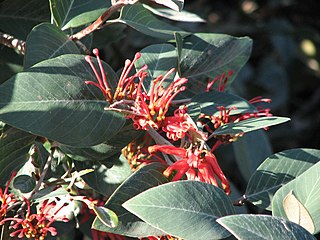
Grevillea burrowa, commonly known as Burrowa grevillea, is a species of flowering plant in the family Proteaceae and is endemic to a restricted area of Victoria, Australia. It is a spreading shrub with oblong to egg-shaped leaves, and clusters of reddish-pink flowers.

Grevillea pachylostyla, commonly known as Buchan River grevillea, is a species of flowering plant in the family Proteaceae and is endemic to Victoria in Australia. It is a mounded to almost prostrate shrub with divided leaves, the end lobes triangular, and usually down-curved, more or less toothbrush-like clusters of cream-coloured flowers that turn` pink to red after opening.

Grevillea confertifolia, commonly known as Grampians grevillea or dense-leaf grevillea, is a species of flowering plant in the family Proteaceae and is endemic to the Grampians in Victoria, Australia. It is a spreading, often dense shrub with linear to narrowly oblong leaves, and reddish-purple flowers.

Grevillea ilicifolia, commonly known as holly grevillea or holly bush, is a species of flowering plant in the family Proteaceae and is endemic to southern continental Australia. It is a spreading to prostrate shrub with holly-like leaves with sharply-pointed triangular to egg-shaped teeth or lobes, and clusters of green to cream-coloured and mauve flowers with a pink to red style.

Grevillea parvula , commonly known as Genoa grevillea, is a species of flowering plant in the family Proteaceae and is endemic to an area near the border between New South Wales and Victoria in south-eastern continental Australia. It is a spreading to erect shrub, usually with elliptic leaves, and down-turned clusters of pinkish to red flowers.

Grevillea micrantha, also known as small-flower grevillea, is a species of flowering plant in the family Proteaceae and is endemic to Victoria in Australia. It is a spreading shrub with linear leaves and clusters of white to pale pink flowers.

Grevillea callichlaena, commonly known as Mt. Benambra grevillea, is a species of flowering plant in the family Proteaceae and is endemic to a restricted part of Victoria in Australia. It is a spreading shrub with elliptic, egg-shaped or broadly lance-shaped leaves, and uniformly red flowers.

Grevillea renwickiana is a species of flowering plant in the family Proteaceae and is endemic to south-eastern New South Wales. It is a prostrate, mat-forming shrub with pinnatifid to pinnatipartite leaves and clusters of cream-coloured to pale pink and purplish flowers.

Grevillea rara, also known as the rare grevillea, is a species of flowering plant in the family Proteaceae and is endemic to a restricted part of the South West region of Western Australia. It is a prostrate, sprawling shrub when young, later a dense, prickly shrub with pinnatisect leaves with linear lobes, and clusters of white to pale pink flowers.
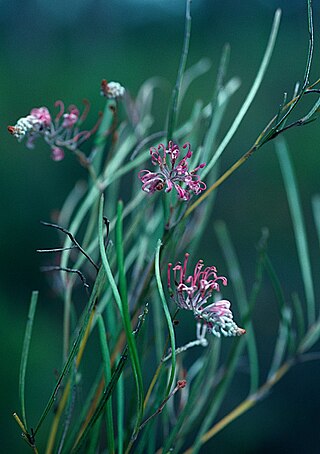
Grevillea reptans, also known as the Tin Can Bay grevillea, is a species of flowering plant in the family Proteaceae and is endemic to south-eastern Queensland. It is usually a prostrate shrub with long vine-like or arching branches, more or less linear leaves, and branched clusters of mauve-pink flowers.




















